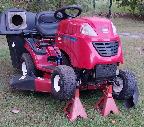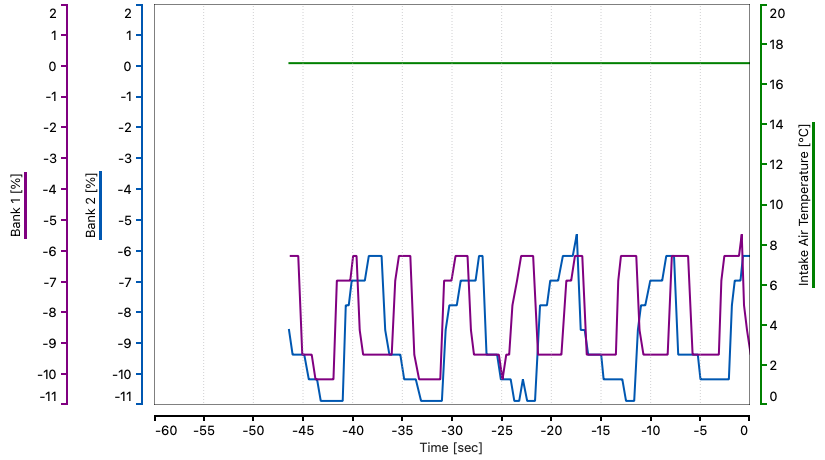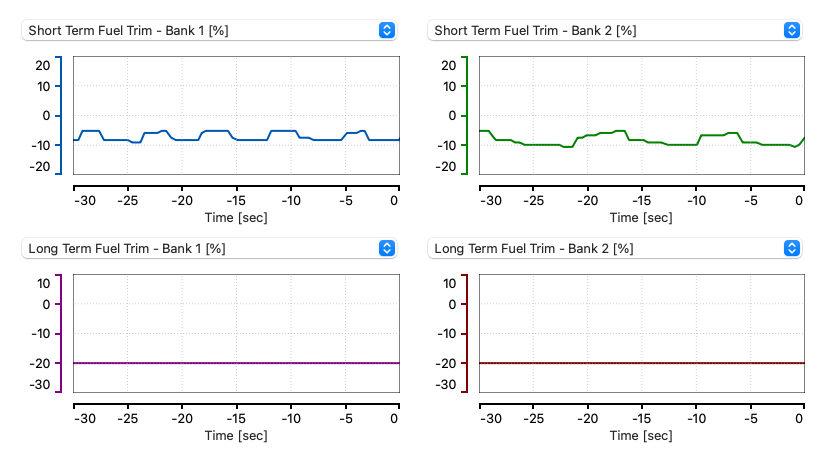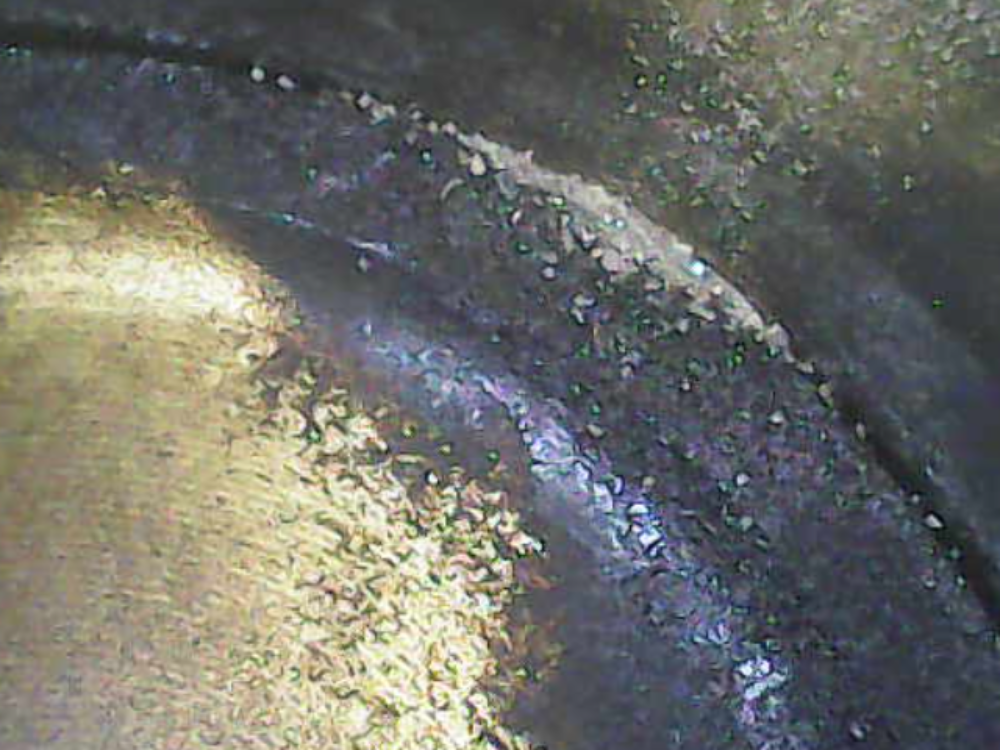Help us help you. By posting the year, make, model and engine near the beginning of your help request, followed by the symptoms (no start, high idle, misfire etc.) Along with any prevalent Diagnostic Trouble Codes, aka DTCs, other forum members will be able to help you get to a solution more quickly and easily!
Ford E-350 Van 5.4 2014 254,000 miles P0172 P0175
- Viktar
-
Topic Author
- Offline
- New Member
-

Less
More
- Posts: 2
- Thank you received: 0
8 months 3 weeks ago - 8 months 3 weeks ago #88118
by Viktar
Ford E-350 Van 5.4 2014 254,000 miles P0172 P0175 was created by Viktar
Hello everyone from the new one on this forum.
I have been using my van for 3 months.
Since the moment of purchase it has had these error codes P0172 Too Rich Bank 1, P0175 Too Rich Bank 2.
Replaced: air filter, spark plugs NGK, injectors Amazon, MAF sensor Denso, all 4 oxygen sensors (Motorcraft Upstream, Denso Downstream), catalytic converter EPA approved.
The old original catalytic converter intake pipes and exhaust manifold are completely free of deposits inside and have a uniform, fairly light color. When replacing the spark plugs, the endoscope showed surprisingly clean aluminum piston heads with a slight coating of carbon deposits, despite the mileage (254,000). The spark plugs were also the same gray color with no traces of oil at all.
After replacing the spark plugs, MAF sensor and injectors at the same time, the engine definitely started to run more smoothly, the shooting sounds in the muffler when releasing the gas pedal at idle almost disappeared. I can’t understand the obvious reasons for this behavior, the only weak point I see is the injectors and spark plug coils. But there are no misfires, according to diagnostic programs and the car really drives well.
Van drives well, accelerates well, idling is not perfectly smooth, starts cold and hot always well and holds increased rpm after starting even when hot for about 5 seconds. Fuel consumption is about 16 MPG, which I think is normal. Fuel pressure has been checked - it is stable at about 50 PSI. When the engine stops, the pressure drops within about 10 minutes. When starting, it rises instantly.
I am attaching a freeze frame and asking for help.
I have an extended version of Forscan, the correct cable for it, OBD WIZ Windows app, OBD Autodoctor Mac, OBDLinkMX+
Thank you in advance for those interested and those who respond.
Freeze frame
Confirmed Diagnostic Trouble Codes
-P0172: System Too Rich Bank 1 (Powertrain, Generic)
-P0175: System Too Rich Bank 2 (Powertrain, Generic)
Pending Diagnostic Trouble Codes
-P0175: System Too Rich Bank 2 (Powertrain, Generic)
Permanent Diagnostic Trouble Codes
-P0172: System Too Rich Bank 1 (Powertrain, Generic)
-P0175: System Too Rich Bank 2 (Powertrain, Generic)
Freeze Frame #0
-P0172: System Too Rich Bank 1 (Powertrain, Generic)
-Fuel system status / Fuel system A: Closed loop (1)
-Fuel system status / Fuel system B: NA
-Calculated engine load: 26.3 %
-Engine Coolant Temperature: 72 °C =161.6 °F
-Short Term Fuel Trim - Bank 1: -18.0 %
-Long Term Fuel Trim - Bank 1: -20.3 %
-Short Term Fuel Trim - Bank 2: -17.2 %
-Long Term Fuel Trim - Bank 2: -20.3 %
-Engine RPM: 652 RPM
-Vehicle Speed Sensor: 27 km/h=16.8 miles/hour
-Ignition Timing Advance for #1 Cylinder: 16.5
-Intake Air Temperature: 6 °C =42.8 °F
-Air Flow Rate from Mass Flow Sensor: 7.23 g/s
-Absolute Throttle Position: 14.9 %
-Bank 1 - Sensor 2 (O2S) / Oxygen Sensor Output Voltage: 0.740 V
-Bank 1 - Sensor 2 (O2S) / Short Term Fuel Trim: --
-Bank 2 - Sensor 2 (O2S) / Oxygen Sensor Output Voltage: 0.740 V
-Bank 2 - Sensor 2 (O2S) / Short Term Fuel Trim: --
-Auxiliary Input Status: Power Take Off: Not active
-Time Since Engine Start: 4 min 21 s
-Commanded Evaporative Purge: 0.0 %
-Fuel Level Input: 62.0 %
-Number of warm-ups since DTCs cleared: 1
-Distance traveled since DTCs cleared: 130 km = 81 miles
-Evap System Vapor Pressure: 111.3 Pa
-Barometric Pressure: 97 kPa
-Bank 1 - Sensor 1 (wide range O2S) / Equivalence Ratio (lambda): 1.051
-Bank 1 - Sensor 1 (wide range O2S) / Oxygen Sensor Current: 0.08 mA
-Bank 2 - Sensor 1 (wide range O2S) / Equivalence Ratio (lambda): 1.047
-Bank 2 - Sensor 1 (wide range O2S) / Oxygen Sensor Current: 0.06 mA
-Catalyst Temperature Bank 1, Sensor 1: 607 °C=1,124.6 °F
-Catalyst Temperature Bank 2, Sensor 1: 607 °C=1,124.6 °F
-Control module voltage: 13.79 V
-Absolute Load Value: 18.4 %
-Fuel/Air Commanded Equivalence Ratio: 1.000
-Relative Throttle Position: 2.0 %
-Ambient Air Temperature: 5 °C=41 °F
-Absolute Throttle Position B: 18.0 %
-Accelerator Pedal Position 15.3 %
15.3 %
-Accelerator Pedal Position E: 7.8 %
-Commanded Throttle Actuator Control: 3.5 %
-Alcohol Fuel Percentage: 5.1 %
Diagnostic information provided by OBD Auto Doctor
I have been using my van for 3 months.
Since the moment of purchase it has had these error codes P0172 Too Rich Bank 1, P0175 Too Rich Bank 2.
Replaced: air filter, spark plugs NGK, injectors Amazon, MAF sensor Denso, all 4 oxygen sensors (Motorcraft Upstream, Denso Downstream), catalytic converter EPA approved.
The old original catalytic converter intake pipes and exhaust manifold are completely free of deposits inside and have a uniform, fairly light color. When replacing the spark plugs, the endoscope showed surprisingly clean aluminum piston heads with a slight coating of carbon deposits, despite the mileage (254,000). The spark plugs were also the same gray color with no traces of oil at all.
After replacing the spark plugs, MAF sensor and injectors at the same time, the engine definitely started to run more smoothly, the shooting sounds in the muffler when releasing the gas pedal at idle almost disappeared. I can’t understand the obvious reasons for this behavior, the only weak point I see is the injectors and spark plug coils. But there are no misfires, according to diagnostic programs and the car really drives well.
Van drives well, accelerates well, idling is not perfectly smooth, starts cold and hot always well and holds increased rpm after starting even when hot for about 5 seconds. Fuel consumption is about 16 MPG, which I think is normal. Fuel pressure has been checked - it is stable at about 50 PSI. When the engine stops, the pressure drops within about 10 minutes. When starting, it rises instantly.
I am attaching a freeze frame and asking for help.
I have an extended version of Forscan, the correct cable for it, OBD WIZ Windows app, OBD Autodoctor Mac, OBDLinkMX+
Thank you in advance for those interested and those who respond.
Freeze frame
Confirmed Diagnostic Trouble Codes
-P0172: System Too Rich Bank 1 (Powertrain, Generic)
-P0175: System Too Rich Bank 2 (Powertrain, Generic)
Pending Diagnostic Trouble Codes
-P0175: System Too Rich Bank 2 (Powertrain, Generic)
Permanent Diagnostic Trouble Codes
-P0172: System Too Rich Bank 1 (Powertrain, Generic)
-P0175: System Too Rich Bank 2 (Powertrain, Generic)
Freeze Frame #0
-P0172: System Too Rich Bank 1 (Powertrain, Generic)
-Fuel system status / Fuel system A: Closed loop (1)
-Fuel system status / Fuel system B: NA
-Calculated engine load: 26.3 %
-Engine Coolant Temperature: 72 °C =161.6 °F
-Short Term Fuel Trim - Bank 1: -18.0 %
-Long Term Fuel Trim - Bank 1: -20.3 %
-Short Term Fuel Trim - Bank 2: -17.2 %
-Long Term Fuel Trim - Bank 2: -20.3 %
-Engine RPM: 652 RPM
-Vehicle Speed Sensor: 27 km/h=16.8 miles/hour
-Ignition Timing Advance for #1 Cylinder: 16.5
-Intake Air Temperature: 6 °C =42.8 °F
-Air Flow Rate from Mass Flow Sensor: 7.23 g/s
-Absolute Throttle Position: 14.9 %
-Bank 1 - Sensor 2 (O2S) / Oxygen Sensor Output Voltage: 0.740 V
-Bank 1 - Sensor 2 (O2S) / Short Term Fuel Trim: --
-Bank 2 - Sensor 2 (O2S) / Oxygen Sensor Output Voltage: 0.740 V
-Bank 2 - Sensor 2 (O2S) / Short Term Fuel Trim: --
-Auxiliary Input Status: Power Take Off: Not active
-Time Since Engine Start: 4 min 21 s
-Commanded Evaporative Purge: 0.0 %
-Fuel Level Input: 62.0 %
-Number of warm-ups since DTCs cleared: 1
-Distance traveled since DTCs cleared: 130 km = 81 miles
-Evap System Vapor Pressure: 111.3 Pa
-Barometric Pressure: 97 kPa
-Bank 1 - Sensor 1 (wide range O2S) / Equivalence Ratio (lambda): 1.051
-Bank 1 - Sensor 1 (wide range O2S) / Oxygen Sensor Current: 0.08 mA
-Bank 2 - Sensor 1 (wide range O2S) / Equivalence Ratio (lambda): 1.047
-Bank 2 - Sensor 1 (wide range O2S) / Oxygen Sensor Current: 0.06 mA
-Catalyst Temperature Bank 1, Sensor 1: 607 °C=1,124.6 °F
-Catalyst Temperature Bank 2, Sensor 1: 607 °C=1,124.6 °F
-Control module voltage: 13.79 V
-Absolute Load Value: 18.4 %
-Fuel/Air Commanded Equivalence Ratio: 1.000
-Relative Throttle Position: 2.0 %
-Ambient Air Temperature: 5 °C=41 °F
-Absolute Throttle Position B: 18.0 %
-Accelerator Pedal Position
 15.3 %
15.3 %-Accelerator Pedal Position E: 7.8 %
-Commanded Throttle Actuator Control: 3.5 %
-Alcohol Fuel Percentage: 5.1 %
Diagnostic information provided by OBD Auto Doctor
Last edit: 8 months 3 weeks ago by Viktar.
Please Log in or Create an account to join the conversation.
- Noah
-

- Offline
- Moderator
-

- Give code definitions with numbers!
Less
More
- Posts: 4957
- Thank you received: 1111
8 months 3 weeks ago #88209
by Noah
"Ground cannot be checked with a 10mm socket"
Replied by Noah on topic Ford E-350 Van 5.4 2014 254,000 miles P0172 P0175
The only thing I see that stands out immediately in the freeze frame data is that the MAF was reporting over 7 grams per second at around 600rpm. If the one gram per second per litre of displacement rule holds true, I would expect 5.4ish gps from the MAF at idle. Definitely make sure the new MAF as well as the air filter and housing are installed correctly.
if it's been running rich for very long, an oil change is warranted. The oil may be contaminated with excess fuel. This can skew the fuel trims positive due to breathing the vapor through the PCV system.
Some other thoughts, over filling the fuel tank can cause canister saturation, coupled with an open purge valve can create rich condition at idle.
Also, I really recommend against fuel injectors from Amazon. It's more likely to add a problem than fix one.
if it's been running rich for very long, an oil change is warranted. The oil may be contaminated with excess fuel. This can skew the fuel trims positive due to breathing the vapor through the PCV system.
Some other thoughts, over filling the fuel tank can cause canister saturation, coupled with an open purge valve can create rich condition at idle.
Also, I really recommend against fuel injectors from Amazon. It's more likely to add a problem than fix one.
"Ground cannot be checked with a 10mm socket"
Please Log in or Create an account to join the conversation.
- Viktar
-
Topic Author
- Offline
- New Member
-

Less
More
- Posts: 2
- Thank you received: 0
8 months 3 weeks ago - 8 months 3 weeks ago #88217
by Viktar
Replied by Viktar on topic Ford E-350 Van 5.4 2014 254,000 miles P0172 P0175
Thank you Noah for the answer.
The signature shows a deep understanding of automotive life)))
Regarding oil saturation with fuel and EVAP reservoir, it is logical.
Of course, the MAF sensor and the adjacent parts are installed accordingly.
With the original old MAF sensor, spark plugs, injectors and catalytic converter, the engine's behavior was basically the same, only less fresh, so to speak.
However, as I described, the van accelerates and drives perfectly, with reasonable fuel consumption. While driving, the STFT and LTFT parameters are constantly monitored using the Forscan mobile application.
And here's what's interesting. If the engine is running under load while driving, constant or increasing, the parameters are normal, i.e. each of them is less than 10 percent. But as soon as the engine goes into idle mode or load reduction, the negative numbers begin to grow.
And another interesting point. If you forcibly engage only the first gear and accelerate the engine while driving to 2-2.5 thousand revolutions, and then suddenly release the accelerator, the van drives for some time without releasing the accelerator, about a second and a half, while the STFT correction numbers approach 0. Together with reaching zero, the efficient operation of the engine abruptly stops.
The graphs of several throttle position readings strictly follow the actual accelerator pedal position. And only the graphs of the EVAP valves match the engine behavior.
From this we can conclude that there is indeed an excess of fuel in the transient mode. What I described in the original post - when dropping high revs while not moving, there is a pop in the muffler.
Also, every time the engine starts, even when hot, it runs at high revs, about 1000 about 5 seconds. And the drop in speed coincides with the start of the STFT readings. Perhaps it is just a row, but not together. To be honest, I don't remember whether this was the case with my previous exactly the same vans or not.
Before proceeding to further steps of electronic diagnostics, I will replace the injectors with BOSCH, fortunately, Rockauto offers them now at a reasonable price. And at the same time, I will measure the engine compression.
Updates will follow.
P.S. At the moment, there is no check engine light. It went out today, but the ECU still contains the code P0172C and in another section P0172 and P0175.
Let me thank you Noah again for your help.
The signature shows a deep understanding of automotive life)))
Regarding oil saturation with fuel and EVAP reservoir, it is logical.
Of course, the MAF sensor and the adjacent parts are installed accordingly.
With the original old MAF sensor, spark plugs, injectors and catalytic converter, the engine's behavior was basically the same, only less fresh, so to speak.
However, as I described, the van accelerates and drives perfectly, with reasonable fuel consumption. While driving, the STFT and LTFT parameters are constantly monitored using the Forscan mobile application.
And here's what's interesting. If the engine is running under load while driving, constant or increasing, the parameters are normal, i.e. each of them is less than 10 percent. But as soon as the engine goes into idle mode or load reduction, the negative numbers begin to grow.
And another interesting point. If you forcibly engage only the first gear and accelerate the engine while driving to 2-2.5 thousand revolutions, and then suddenly release the accelerator, the van drives for some time without releasing the accelerator, about a second and a half, while the STFT correction numbers approach 0. Together with reaching zero, the efficient operation of the engine abruptly stops.
The graphs of several throttle position readings strictly follow the actual accelerator pedal position. And only the graphs of the EVAP valves match the engine behavior.
From this we can conclude that there is indeed an excess of fuel in the transient mode. What I described in the original post - when dropping high revs while not moving, there is a pop in the muffler.
Also, every time the engine starts, even when hot, it runs at high revs, about 1000 about 5 seconds. And the drop in speed coincides with the start of the STFT readings. Perhaps it is just a row, but not together. To be honest, I don't remember whether this was the case with my previous exactly the same vans or not.
Before proceeding to further steps of electronic diagnostics, I will replace the injectors with BOSCH, fortunately, Rockauto offers them now at a reasonable price. And at the same time, I will measure the engine compression.
Updates will follow.
P.S. At the moment, there is no check engine light. It went out today, but the ECU still contains the code P0172C and in another section P0172 and P0175.
Let me thank you Noah again for your help.
Last edit: 8 months 3 weeks ago by Viktar.
Please Log in or Create an account to join the conversation.
- Monde
-
- Offline
- Elite Member
-

Less
More
- Posts: 220
- Thank you received: 43
8 months 3 weeks ago - 8 months 3 weeks ago #88394
by Monde
Assuming is never a good thing.
Replied by Monde on topic Ford E-350 Van 5.4 2014 254,000 miles P0172 P0175
Hello everyone from the new one on this forum.
I have been using my van for 3 months.
Since the moment of purchase it has had these error codes P0172 Too Rich Bank 1, P0175 Too Rich Bank 2.
Replaced: air filter, spark plugs NGK, injectors Amazon, MAF sensor Denso, all 4 oxygen sensors (Motorcraft Upstream, Denso Downstream), catalytic converter EPA approved.
The old original catalytic converter intake pipes and exhaust manifold are completely free of deposits inside and have a uniform, fairly light color. When replacing the spark plugs, the endoscope showed surprisingly clean aluminum piston heads with a slight coating of carbon deposits, despite the mileage (254,000). The spark plugs were also the same gray color with no traces of oil at all.
After replacing the spark plugs, MAF sensor and injectors at the same time, the engine definitely started to run more smoothly, the shooting sounds in the muffler when releasing the gas pedal at idle almost disappeared. I can’t understand the obvious reasons for this behavior, the only weak point I see is the injectors and spark plug coils. But there are no misfires, according to diagnostic programs and the car really drives well.
Van drives well, accelerates well, idling is not perfectly smooth, starts cold and hot always well and holds increased rpm after starting even when hot for about 5 seconds. Fuel consumption is about 16 MPG, which I think is normal. Fuel pressure has been checked - it is stable at about 50 PSI. When the engine stops, the pressure drops within about 10 minutes. When starting, it rises instantly.
I am attaching a freeze frame and asking for help.
I have an extended version of Forscan, the correct cable for it, OBD WIZ Windows app, OBD Autodoctor Mac, OBDLinkMX+
Thank you in advance for those interested and those who respond.
Freeze frame
Confirmed Diagnostic Trouble Codes
-P0172: System Too Rich Bank 1 (Powertrain, Generic)
-P0175: System Too Rich Bank 2 (Powertrain, Generic)
Pending Diagnostic Trouble Codes
-P0175: System Too Rich Bank 2 (Powertrain, Generic)
Permanent Diagnostic Trouble Codes
-P0172: System Too Rich Bank 1 (Powertrain, Generic)
-P0175: System Too Rich Bank 2 (Powertrain, Generic)
Freeze Frame #0
-P0172: System Too Rich Bank 1 (Powertrain, Generic)
-Fuel system status / Fuel system A: Closed loop (1)
-Fuel system status / Fuel system B: NA
-Calculated engine load: 26.3 %
-Engine Coolant Temperature: 72 °C =161.6 °F
-Short Term Fuel Trim - Bank 1: -18.0 %
-Long Term Fuel Trim - Bank 1: -20.3 %
-Short Term Fuel Trim - Bank 2: -17.2 %
-Long Term Fuel Trim - Bank 2: -20.3 %
-Engine RPM: 652 RPM
-Vehicle Speed Sensor: 27 km/h=16.8 miles/hour
-Ignition Timing Advance for #1 Cylinder: 16.5
-Intake Air Temperature: 6 °C =42.8 °F
-Air Flow Rate from Mass Flow Sensor: 7.23 g/s
-Absolute Throttle Position: 14.9 %
-Bank 1 - Sensor 2 (O2S) / Oxygen Sensor Output Voltage: 0.740 V
-Bank 1 - Sensor 2 (O2S) / Short Term Fuel Trim: --
-Bank 2 - Sensor 2 (O2S) / Oxygen Sensor Output Voltage: 0.740 V
-Bank 2 - Sensor 2 (O2S) / Short Term Fuel Trim: --
-Auxiliary Input Status: Power Take Off: Not active
-Time Since Engine Start: 4 min 21 s
-Commanded Evaporative Purge: 0.0 %
-Fuel Level Input: 62.0 %
-Number of warm-ups since DTCs cleared: 1
-Distance traveled since DTCs cleared: 130 km = 81 miles
-Evap System Vapor Pressure: 111.3 Pa
-Barometric Pressure: 97 kPa
-Bank 1 - Sensor 1 (wide range O2S) / Equivalence Ratio (lambda): 1.051
-Bank 1 - Sensor 1 (wide range O2S) / Oxygen Sensor Current: 0.08 mA
-Bank 2 - Sensor 1 (wide range O2S) / Equivalence Ratio (lambda): 1.047
-Bank 2 - Sensor 1 (wide range O2S) / Oxygen Sensor Current: 0.06 mA
-Catalyst Temperature Bank 1, Sensor 1: 607 °C=1,124.6 °F
-Catalyst Temperature Bank 2, Sensor 1: 607 °C=1,124.6 °F
-Control module voltage: 13.79 V
-Absolute Load Value: 18.4 %
-Fuel/Air Commanded Equivalence Ratio: 1.000
-Relative Throttle Position: 2.0 %
-Ambient Air Temperature: 5 °C=41 °F
-Absolute Throttle Position B: 18.0 %
-Accelerator Pedal Position15.3 %
-Accelerator Pedal Position E: 7.8 %
-Commanded Throttle Actuator Control: 3.5 %
-Alcohol Fuel Percentage: 5.1 %
Diagnostic information provided by OBD Auto Doctor
Get the engine to reach about 190 degrees and see if the MAF grams per sec drops to 5.4 or close to it. I wonder why the equivalent ratio for both wide band sensors show 1.051 and 1.047 when the commanded ratio is 1.000. Both front sensors report a lean mixture while the rear o2s report a rich condition Have you checked the accuracy of the front sensors by driving them lean and rich? Let us make sure that the sensors are reading accurately before going further.
Assuming is never a good thing.
Last edit: 8 months 3 weeks ago by Monde.
The following user(s) said Thank You: Noah
Please Log in or Create an account to join the conversation.
Time to create page: 0.308 seconds



